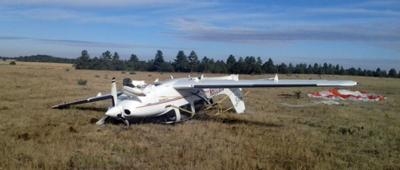Pilot Reported Loss Of Engine Oil Pressure, CAP System Deployed
The NTSB's preliminary report in an accident involving a modified Cirrus SR22 airplane in Arizona last week adds details to published media reports about the incident. In the preliminary report, the board indicates that the pilot heard a "loud pop" about four minutes prior to seeing an annunciator light indicating an oil pressure problem with the airplane. The CAP system allowed the pilot to escape the incident with only minor injuries.

NTSB Identification: WPR13LA043
14 CFR Part 91: General Aviation
Accident occurred Friday, November 16, 2012 in Show Low, AZ
Aircraft: CIRRUS SR22, registration: N800RW
Injuries: 1 Minor.
This is preliminary information, subject to change, and may contain errors. Any errors in this report will be corrected when the final report has been completed. NTSB investigators may not have traveled in support of this investigation and used data provided by various sources to prepare this aircraft accident report.
On November 16, 2012, about 0726 mountain standard time, a Cirrus design SR22, N800RW, was substantially damaged when the airplane descended to the ground under parachute near Show Low, Arizona, after the engine experienced a complete loss of oil pressure during cruise flight. The pilot/owner received minor injuries. The personal flight was conducted under the provisions of Title 14 Code of Federal Regulations Part 91. Visual meteorological conditions prevailed, and the flight was operating on an FAA instrument flight rules (IFR) flight plan.
According to the pilot, he departed Animas Airpark (00C), Durango Colorado, about 0600, with an intended destination of Nogales International Airport (OLS), Nogales, Arizona. About 2 hours into the flight, while in cruise flight at 12,000 feet above mean sea level, air traffic control (ATC) cleared him to 14,000 feet for terrain clearance purposes. Just before the airplane reached the new assigned altitude, the pilot heard a loud "pop." About 4 minutes later, the pilot received an oil pressure annunciation on his primary flight display. At that time the indicated oil pressure was about 47 pounds per square inch (psi), which was at the bottom of the normal range. Within 1 minute the pilot saw the oil pressure had decreased to 0 psi, so he shut down the engine and advised ATC. He asked for vectors to the nearest airport, was advised that Show Low Regional Airport (SOW), was the closest, and then turned towards SOW. During the descent, about the same time that ATC advised him that radar contact had
been lost, the pilot recognized that he would be unable to reach SOW, and advised ATC that he would deploy the ballistic parachute when he was over terrain that appeared suitable for a parachute landing. The pilot estimated that he deployed the parachute between 1,000 and 2,000 feet above ground level. The airplane came down in a field. The pilot exited the airplane and contacted assistance via his satellite telephone. The pilot and airplane were located about 2 hours after the landing, aided by his reinflation of the parachute and use of his personal mobile telephone (not satellite phone).
On-scene examination by an FAA inspector revealed that engine oil was deposited along the bottom and left side of the airplane. FAA records indicated that the airplane was manufactured in 2005, and was purchased new by the pilot. In February 2009, a Forced Aeromotive Technologies supercharger was installed in accordance with supplemental type certificate SA10925SC. The pilot held a private pilot certificate with airplane single and multi-engine and instrument airplane ratings.
The 0735 automated weather observation at SOW, located about 8 miles north of the landing site, included calm winds; clear skies; temperature 1 degree C; dew point -5 degrees C; and an altimeter setting of 30.25 inches of mercury.
(Image provided by Navajo County, AZ, sheriff's department)
 ANN's Daily Aero-Linx (04.15.24)
ANN's Daily Aero-Linx (04.15.24) Classic Aero-TV: 'No Other Options' -- The Israeli Air Force's Danny Shapira
Classic Aero-TV: 'No Other Options' -- The Israeli Air Force's Danny Shapira Aero-News: Quote of the Day (04.15.24)
Aero-News: Quote of the Day (04.15.24) Airborne 04.16.24: RV Update, Affordable Flying Expo, Diamond Lil
Airborne 04.16.24: RV Update, Affordable Flying Expo, Diamond Lil ANN's Daily Aero-Term (04.16.24): Chart Supplement US
ANN's Daily Aero-Term (04.16.24): Chart Supplement US



